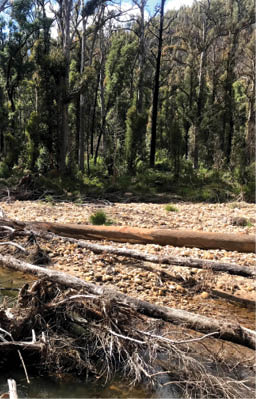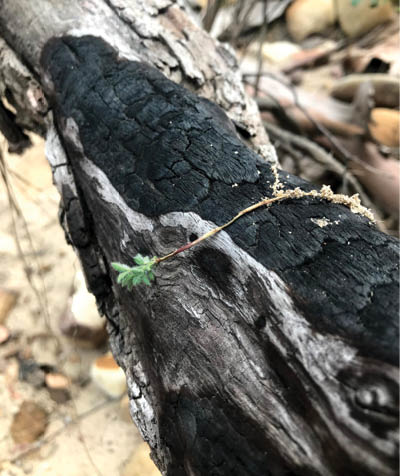{{{description}}}




The same bridge tossed to the side, October 2021
Andy Macqueen’s excellent book Back from the Brink (2007) chronicles the history of the forest from a non-indigenous perspective and its importance as the “cradle of conservation”. I love looking at the old black and white photos of walkers, artists, farmers, engineers and loggers, as they stand in front of the huge tree that marks the junction between the Perrys Lookdown, Acacia Flat, Burra Korain and Du Faur Head tracks. I have heard that tree described as “the Grandfather Tree” and it seems an apt description as it towers over all others, marking the end of a heavy journey or the start of a steep one.
Or it did.
Bushfires and floods in the Blue Gum ForestThis is a story of the impact of recent weather on the Blue Gum Forest (the forest) from a frequent visitor’s point of view. The forest and its magnificent trees not only suffered the devastation of the 2019-20 bushfires, but also many years of drought, and two significant follow up floods. The culmination of these events has left the area unrecognisable.
If you have not visited the forest after March 2021, prepare yourself for a shock. Not only is the misty canopy of Blue Gum gone, but the March 2021 flood has resulted in a changed water course. The ridges and gullies leading down into the forest are scored with deep crevices as minor tributaries that usually trickle into Govetts Creek have carved out tonnes of sand and scree, dumping it onto the flat below. Huge landslips are evident high on the sheer walls of the Grose, including one which locals have taken to calling “the seahorse”.
In the forest, some trees initially carried water marks 2-4 metres from their base and that is if you could see the base. Many of the trees now have sand, stone and debris dumped at their feet. You may be familiar with the fallen tree bridge that allows a walker to cross the creek to Du Faur Head or Walford Gully, without so much as a wet toe; it was thrown to the side like a toothpick. The first photo below shows the log in 2018. The second photo is from October 2021, wedged in boulders some 20 metres behind where the walker sits in the first photo.
Walker on natural bridge over Govetts Creek, 2018
BWA December 2021 | 45






December 2018
RecoveryYou might be asking, will the forest recover? Well, the answer is only time will tell. National Parks and Wildlife Service (NPWS) is undertaking a study of hundreds of trees to answer that question, and if you are down there, that is what all the pink tape is about. As I write in October 2021, some of them appear unrecoverable, but others are recovering, and it will be a slow process. My photos below of the forest in 2018, October 2020 and October 2021 give some indication of the magnitude of the destruction.
But in order for the area to recover, it’s not just the trees but the whole forest we have to consider. During 2020 when the area remained closed, I was fortunate to be part of a volunteer remote weeding team with NPWS, hoping to get a head start on the weeds emerging in the first spring after the fires.
In October 2020 when it was first deemed safe for us to visit, (charred trees still crashed to the ground in the distance, and sections of the track were obliterated) we started pulling Scotch Broom and Gorse.
These weeds were thought to have been bought under control 10 years ago, but the seeds remain dormant and will very happily take over if given a chance. If you don’t know what they look like they are the super bright yellow bushes you find often on the clifftops and occupied ridges of the Upper Blue Mountains. On the next page is a photo
of Scotch Broom on the top of a ridge in Blackheath in a vacant house block and a seedling pulled out on the banks of Govetts Creek. Not only do you have to worry about the seed bed remaining dormant, the seed is water dispersed so it is washed into the Grose Wilderness Area from the creeks upstream. Weeds of the Blue Mountains is a great source of information for those keen to find out what is, and is not, a weed in the bush.
NPWS weed teams and Bushcare groups have been working all spring 2020 and into autumn 2021, hoping to remove the seedlings before they can take hold. This allows the native vegetation to recover, giving the forest a better chance of recovery.
For me, this means finding and pulling weeds about 1 inch high from the sandy banks of Govetts Creek and its tributaries for a few days and weekends a year. Each seedling is pulled by hand, to ensure minimal damage to the surrounding native vegetation. It is vital that the native vegetation is left in place to stabilise the creek bank and outcompete the weeds. The volunteer team I worked with can cover about 500-1000 metres creek line in two days. Big infestations are marked for commercial teams to manage. All of this falls to the management of the lone ranger of the Grose Valley (there is only one for the whole Grose!). For anyone wanting to get involved, I highly recommend it. Just get in touch with NPWS Blackheath.
October 2020
October 2021
46 | BWA December 2021





Things we can do to helpBut there are other things we can all do, when COVID-19 lockdowns permit, and many of our feet start walking through this magnificent space. Here’s a few suggestions. I am sure there are many others. Firstly, be mindful that the area is still recovering. Stay on marked or used tracks. Popular tracks like Perrys and Burra Korain, have been rebuilt, are wider and have far better design for environmental management. Camp in designated areas only and don’t have a fire, unless permitted. Decisions about where fires are permitted are made for lots of reasons. This is not just about bushfire risk.
Your fire might seem small but think about how much wood was burnt. Now multiply that by how many campers visit the area each year. Now compare that to how long it takes for a tree to grow that wood and replace the wood. Fallen timber is habitat for native fauna, and also valuable replacement of nutrients to the soil. Wohlleben’s The Hidden Life of Trees (2015) contains some eye-opening data on this for those interested. Thirdly, check your gear, shoes, tents, etc. before you come. Clean and disinfect them. Don’t bring weeds and fungal diseases like phytophthora in inadvertently. Finally, whatever you carried into the forest, carry it out.
My involvement with the weed team was fuelled by a desire to get back to my “special place” as soon as possible, not from any particular environmental fervour, it just seemed like a “fair exchange” for the privilege of early access. But it has made me realise that the word “exchange” has no relevance in places like the Blue Gum Forest. The forest is not there so I can visit. As I look up and see the old Grandfather Tree’s outstretched limbs torn, barren and leafless, I realise that not everything is forever. We have to look after it.
I am beginning to think that, in my lifetime, I will never again be enveloped in the silvery blue softness and dappled light of the eucalypt canopy. Instead, I will have to content myself with a cuppa and chat with the old tree about “the good ol’ days.” And that, is certainly a conversation worth having.
Scotch Broom seedling Govetts Creek, October 2021
Outcrop of established Scotch Broom
BWA December 2021 | 47